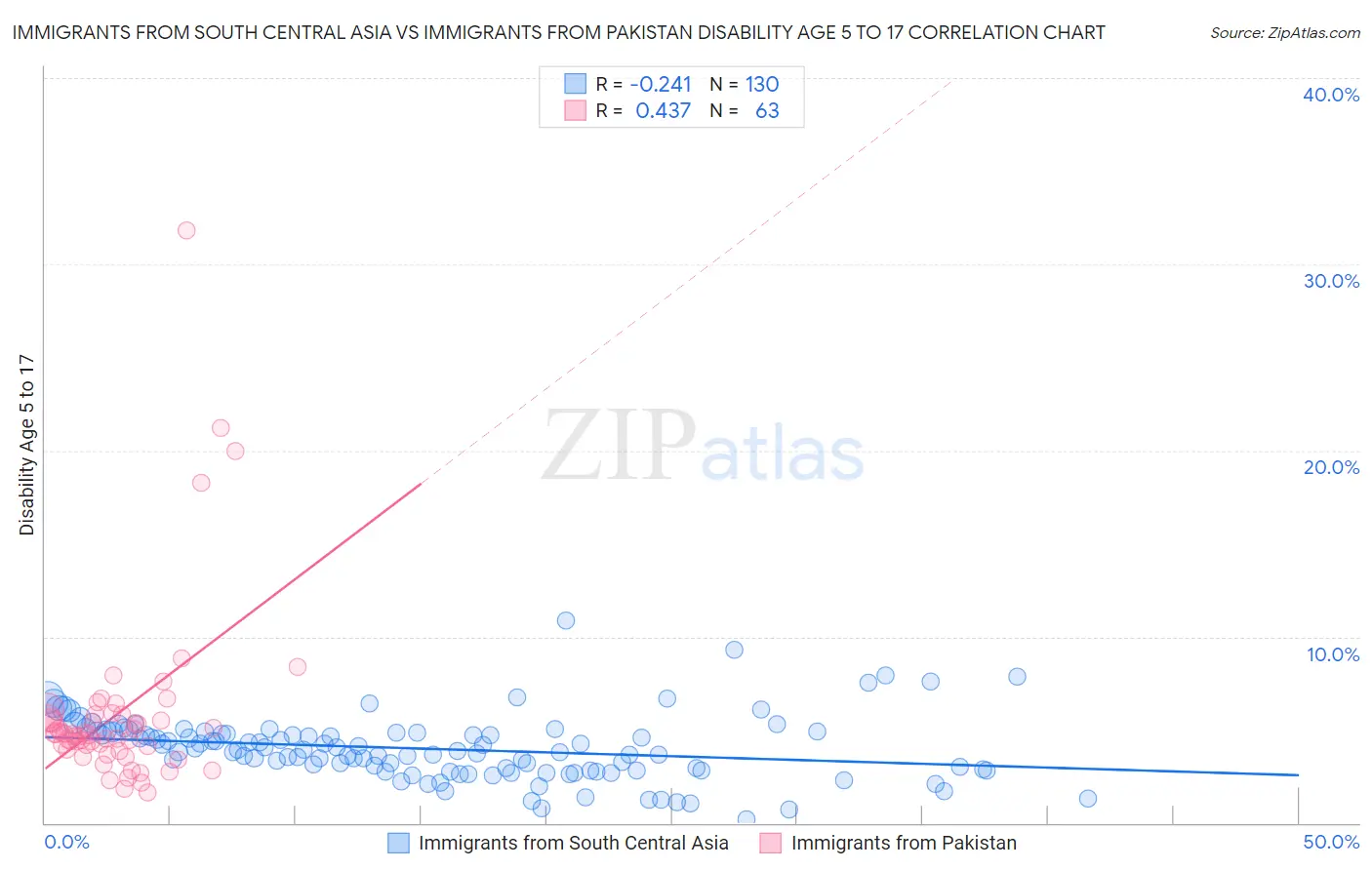Immigrants from South Central Asia vs Immigrants from Pakistan Disability Age 5 to 17
COMPARE
Immigrants from South Central Asia
Immigrants from Pakistan
Disability Age 5 to 17
Disability Age 5 to 17 Comparison
Immigrants from South Central Asia
Immigrants from Pakistan
4.7%
DISABILITY AGE 5 TO 17
100.0/ 100
METRIC RATING
18th/ 347
METRIC RANK
5.0%
DISABILITY AGE 5 TO 17
100.0/ 100
METRIC RATING
31st/ 347
METRIC RANK
Immigrants from South Central Asia vs Immigrants from Pakistan Disability Age 5 to 17 Correlation Chart
The statistical analysis conducted on geographies consisting of 467,856,625 people shows a weak negative correlation between the proportion of Immigrants from South Central Asia and percentage of population with a disability between the ages 5 and 17 in the United States with a correlation coefficient (R) of -0.241 and weighted average of 4.7%. Similarly, the statistical analysis conducted on geographies consisting of 282,773,176 people shows a moderate positive correlation between the proportion of Immigrants from Pakistan and percentage of population with a disability between the ages 5 and 17 in the United States with a correlation coefficient (R) of 0.437 and weighted average of 5.0%, a difference of 4.9%.

Disability Age 5 to 17 Correlation Summary
| Measurement | Immigrants from South Central Asia | Immigrants from Pakistan |
| Minimum | 0.21% | 1.7% |
| Maximum | 10.9% | 31.8% |
| Range | 10.7% | 30.2% |
| Mean | 4.0% | 5.9% |
| Median | 3.9% | 4.8% |
| Interquartile 25% (IQ1) | 2.8% | 3.9% |
| Interquartile 75% (IQ3) | 4.8% | 5.8% |
| Interquartile Range (IQR) | 2.0% | 1.9% |
| Standard Deviation (Sample) | 1.7% | 4.9% |
| Standard Deviation (Population) | 1.7% | 4.8% |
Demographics Similar to Immigrants from South Central Asia and Immigrants from Pakistan by Disability Age 5 to 17
In terms of disability age 5 to 17, the demographic groups most similar to Immigrants from South Central Asia are Arapaho (4.7%, a difference of 0.020%), Immigrants from Singapore (4.7%, a difference of 0.48%), Immigrants from Uzbekistan (4.8%, a difference of 0.49%), Burmese (4.8%, a difference of 0.87%), and Chinese (4.7%, a difference of 0.90%). Similarly, the demographic groups most similar to Immigrants from Pakistan are Soviet Union (5.0%, a difference of 0.040%), Immigrants from Malaysia (5.0%, a difference of 0.25%), Immigrants from Indonesia (5.0%, a difference of 0.36%), Immigrants from Serbia (4.9%, a difference of 0.47%), and Israeli (5.0%, a difference of 0.48%).
| Demographics | Rating | Rank | Disability Age 5 to 17 |
| Immigrants | Korea | 100.0 /100 | #14 | Exceptional 4.7% |
| Chinese | 100.0 /100 | #15 | Exceptional 4.7% |
| Immigrants | Singapore | 100.0 /100 | #16 | Exceptional 4.7% |
| Arapaho | 100.0 /100 | #17 | Exceptional 4.7% |
| Immigrants | South Central Asia | 100.0 /100 | #18 | Exceptional 4.7% |
| Immigrants | Uzbekistan | 100.0 /100 | #19 | Exceptional 4.8% |
| Burmese | 100.0 /100 | #20 | Exceptional 4.8% |
| Yup'ik | 100.0 /100 | #21 | Exceptional 4.8% |
| Asians | 100.0 /100 | #22 | Exceptional 4.8% |
| Immigrants | Bolivia | 100.0 /100 | #23 | Exceptional 4.8% |
| Immigrants | Lebanon | 100.0 /100 | #24 | Exceptional 4.8% |
| Immigrants | Asia | 100.0 /100 | #25 | Exceptional 4.8% |
| Bhutanese | 100.0 /100 | #26 | Exceptional 4.9% |
| Taiwanese | 100.0 /100 | #27 | Exceptional 4.9% |
| Immigrants | Japan | 100.0 /100 | #28 | Exceptional 4.9% |
| Immigrants | Serbia | 100.0 /100 | #29 | Exceptional 4.9% |
| Immigrants | Malaysia | 100.0 /100 | #30 | Exceptional 5.0% |
| Immigrants | Pakistan | 100.0 /100 | #31 | Exceptional 5.0% |
| Soviet Union | 100.0 /100 | #32 | Exceptional 5.0% |
| Immigrants | Indonesia | 100.0 /100 | #33 | Exceptional 5.0% |
| Israelis | 100.0 /100 | #34 | Exceptional 5.0% |